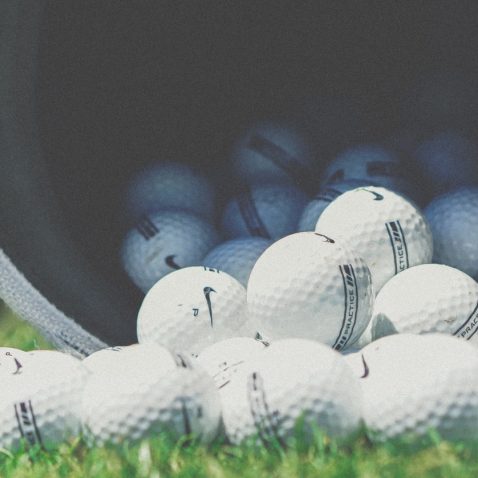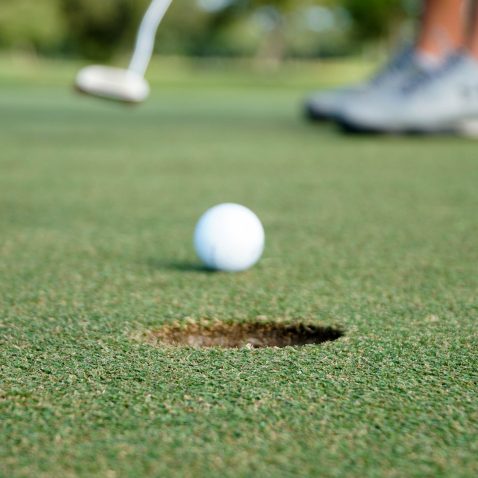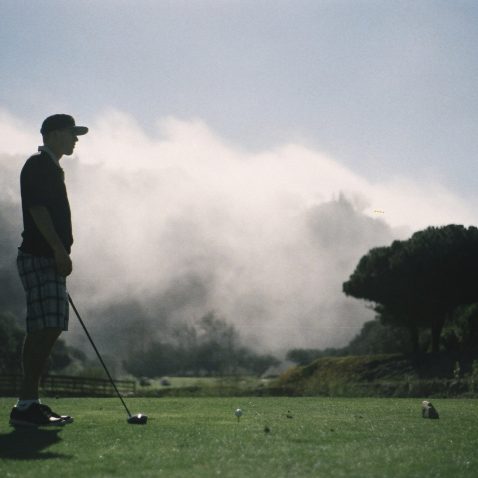Golf Terms You NEED to Know
If you’ve never picked up a club in your life, then this section is a must-read. Give this a read, and you won’t be stood there awkwardly while your fellow golfers are discussing hazards and handicaps. You’ll fit right in with a basic knowledge of the main golf terms. Also included is a “used in a sentence” section, so you can see these words used in context.

Par
You’ll probably hear the word ‘Par’ the most in your game. It’s a nice short word with a nice short definition. It’s the number of strokes that you’re expected to need to complete either a hole or all the holes on the course. Par is the standard that all golfers aspire.
It’s a rule of thumb that the par accounts for two putts. For example, you’d be expected to hit the green with your tee shot. Then, you get two putts to get a par.
If you’re a newbie to the golfing scene, you’ll most likely complete a hole in more strokes than the par – so you’ll be over par.
Talented (or lucky) golfers might complete a hole in fewer strokes than par, which is called being under par.
Where does the Word Originate?
The term ‘par’ translates to ‘equal’ or ‘equality’ in Latin. It was used in the late 16th century to describe a standard level, meaning something is average or ordinary.
The term was first coined by golfers at the end of the 19th Century and was interchangeable with the word ‘Bogey’. This changed in the early 1900s when ‘Par’ came to mean the ideal score that golfers should aim for.
The term “Bogey” evolved to mean essentially the same thing, but for more recreational golfers.
Officially added to the golfing lexicon in 1911, the USGA defined it as “perfect play without flukes and under ordinary weather conditions, always allowing two strokes on each putting green.”
Before this, there’s no clear record of it being used in official golf scoring – as it wasn’t widely used amongst golfers at this point.
The term outside of the golfing lexicon just means a standard. So if you’re on par with somebody, you’re on the same level as them. Or if something is subpar, it’s below average.
Used in a Sentence:
“He finally made par in the 9th hole”.
‘Well, I got three strokes under par on that hole”.
Tee/ Tee Box
You’ll find the tee box at the start of the course. You must hit your first shot from the tee box. If you hit your first shot outside the tee box, it usually results in a penalty.
The tee box is located in different positions depending on your gender, skill level, and experience. The color of your tee box determines how many points you begin with. For example, the tee box for women is typically red and will be located closer to the green.
If you’re a professional golfer, it’s likely that your tee box will be black or gold, and will be further away from the green.
A golf tee is a piece of equipment that raises the ball off the ground, making it easier for the ball to travel longer distances when “teeing off”.
It’s usually a thin peg that’s a couple of inches in height, and it’s pushed into the ground for stability.
Used in a Sentence:
“It’s time to tee off”
“Get in the tee box then”
“But I can’t see the tee markers”
Green
If you’ve never played golf before, then you might not know that the aim of every game of golf is to get the ball into the hole in the putting green.
Past all the obstacles and hazards, this is the final stage of each hole. The flags and cups are located on the green.
The grass on the green is cut super short, making it easier for you to be extra accurate in making your final shot, and so the grass doesn’t get in the way of your ball.
Golf greens can vary in shape and size. They can be flat, sloped or contoured. They tend to get more difficult as the course progresses.
Double Greens
A double green is a larger green that has two different holes. These are usually located on a larger course and can accommodate two different groups of golfers at one time.
These aren’t very common but are more likely to be found in courses in Great Britain and Ireland.
Alternate Greens
This doesn’t really require much of an explanation – an alternate green is where two different greens are made for the same hole (not to be confused with a double green!).
You won’t find alternate greens on every golf course, but they are more common with 9 hole courses.
They are rather uncommon, certainly less common than double greens. This means that when you re-do the course, you’ll be able to use the other green, so it’s like you’re doing a brand new course.
Crowned Green
The green can be made a lot more difficult by elevating the center, so the green slopes down from its middle. They can also be called domed greens, turtleback greens or tortoise-shell greens.
Punchbowl Green
A Punchbowl green is effectively the opposite of a crowned green. The lowest point of the green is in the middle, meaning it slopes down from the edges of the green to the middle point.
A lot of 19th-century greens were in this design, to capture moisture. They’re not used as much now, but you’ll find the odd one here and there.
Used in a Sentence
“How long until we get to the green?”
“I reckon it’ll be another few shots before we make it there”
“Remember it’s a punchbowl green, prepare yourself”
Handicap
A handicap is a measure of your potential ability. So essentially, the lower the number, the better you are. If you’re a newbie to golf, your handicap is naturally going to be higher.
The better you get at golf, the lower your handicap will get.
Your handicap will tell you how many strokes above or below par that you should be able to play. The handicap system allows golfers of all skill levels to play in the same game.
So your handicap is 15, and you’re playing against someone who’s handicap is 10. Your 10 handicap friend must give you 5 strokes before the round starts, essentially giving you a head start.
Hazard
Hazard in general terms just means a danger or a risk. In golf, it means the same, but more specific. A hazard would either be a man-made hazard such as a bunker (see prev definition) or a water hazard, which would be a lake or a river.
These obstacles make the game more difficult (and exciting) as getting your ball stuck in one of these is likely to add strokes to your golf game.
Fairway
The fairway is the well-maintained, shorter area of grass between the tee box and the green. You’re best trying to keep the ball in this area until you get to the green as if it gets into the rough, it makes your next shot tougher.
When you tee off, you’re aiming for the fairway.
Rough
The rough is an area of the course which has longer grass. If you were to hit the ball into the rough, the next shot (to get out of the rough) is going to be more challenging.
This is because the longer grass can slow down both your clubhead and the ball.
The length of the rough on courses can vary from hole to hole. The different lengths of the rough make it more difficult for those players who have missed the fairway.
Used in a Sentence:
“Oh no, the ball has landed in the rough again”
“Unlucky, you’re going to be way above par”
Putt
The word “putt” is another one of the most commonly used golf terms. You’ll putt the ball on the green. It’s a stroke with a club (usually the utter) when you’re trying to get the ball into or near the hole.
The putter can be used on and off the green, so the ball has more direction. If you take a shot with the putter and it is NOT on the green, it doesn’t mean its a putt. So to reiterate, a putt is only when it’s on/ very close to the green. This word derives from the Scottish word that means “push” or “shove”.
Used in a Sentence:
“Just putt already!”
“One moment, it’s a crowned green.”
Scoring Terms
Now you know the basics, it’s time to get to the scoring terms. The scoring process of golf can be confusing for beginners, but don’t fear – this guide has you covered.
The scoring system in golf is very different from most other sports, as the winner of a game of golf is the player with the lowest score.
There are also a lot of bird-related scoring terms, so when you hear other players talking about birdies, eagles, and albatrosses, you’ll understand what they mean after having a read of this section.

Birdie
A birdie is achieved when you’ve completed a hole in fewer strokes than par. Not many golfers can do this regularly, so it is an achievement.
You’ll hear this a lot if you’re a great golfer or a lucky golfer.
Eagle
An eagle is also an achievement in golf. If you complete the hole in two fewer shots than a par, then you’ve scored an eagle.
A double eagle is when you’ve completed the hole in three strokes under par. This is also known as an Albatross.
Ace
If you’re new to golf, you probably won’t hear this word on the course for a while. It’s the best you can get – a hole in one.
An ace will massively benefit your score, and it’s the desired outcome of any golfer. You have to be super skilled (or a lucky mother putter) to score an ace.
Bogey
Amateur golfers will probably be more familiar with this term. This isn’t really a positive term, as it’s used to describe a hole completed with one stroke more than the par. A bogey will raise your score by one, which will be damaging to your score.
- A Double Bogey occurs when it takes you two more strokes than par to complete a hole. This is obviously more damaging to your score than a regular bogey – but not as damaging as a triple bogey.
- A Triple Bogey, as you can guess, increases your score by 3 points, which is super damaging. Pro golfers very rarely get a bogey, let alone a triple bogey.
Equipment Terms
There’s so much equipment in golf, and some of them are obvious and don’t need an explanation. Others, however, are more complex and aren’t obvious to the golf newbie.
Give this guide a read and you’ll be able to play a game of golf and name the most important equipment.

- Ball Marker
Usually a coin or small plastic disk that marks the position of the ball on the green, so your ball doesn’t get in the way of somebody else’s putt. - Cart
A golf cart is a small vehicle used to carry you and your equipment. Not all golfers have them but it certainly makes it easier to lug your equipment around the course – especially if its 18 holes. - Clubface
The clubface is the part of the clubhead that touches the ball. - Dimples
Dimples are the indents on a golf ball. They are not only there for aesthetic purposes – they have a purpose. They produce drag and allow the ball to go a lot further and straighter than a ball without dimples. - Distance Markers
These will be found on the side of the fairway, marking the distance to the green. The markings would usually be 100 yards, 200 or even 250. The distance markers are there to give golfers some perspective on the course. - Front Nine
Holes 1-9. The first 9 holes of the course. - Flag Stick
The flagstick is placed next to the hole. It’s what it says on the tin – a stick with a flag on it. It’s used to locate the hole at distances. - Sand Wedge
This is a special club made for getting the ball out of bunkers. They can also be used within 100 yards for chips, pitches and full swings. - Stimpmeter
You may not use this one if you’re a golf newbie. A stimpmeter is a device that’s used to measure the speed of the putting green, by applying a known force to a golf ball, then measuring the distance traveled (usually in feet). - Wedge
A wedge is iron with high lofts. They usually have the heaviest club heads of all the irons and the shortest shafts. They are most commonly used for approach shots to the green – not for hugely large distances.
Funny Golf Terms
So now you know the serious stuff, let’s move on to some more entertaining words used in golf.
You may have heard these if you’ve been on a golf course before, but if you’re not familiar with the golfing world, some of these terms will sound bizarre to you.

Barkie
If you somehow manage to make a par even after your ball has hit a nearby tree, then you’ve achieved a barkie. Impressive stuff.
Bogey
The definition of the term is above, under “Scoring Terms”, but I couldn’t not include this in the funny words section. You’ll hear this on the course a lot, and if you’re new to the golfing scene, you must try not to laugh every time you hear it in a serious context.
Cabbage
If you hit your ball outside the rough and into bushes or trees, you’re in the cabbage. You want to avoid the cabbage, because if you don’t, you may lose the ball forever.
Chicken Stick
One of the less commonly heard golf expressions, this is just another way of saying your favorite golf club. Your chicken stick is the go-to club that you can always rely on.
It’s the safe option – and can be used to describe a decision that you’ve not had to think too much about. You picked the easy option.
Chunk
You’ll probably hear this a lot if you’re new to the course. If you’re an inexperienced golfer, you’ll probably take chunks out of the ground when you swing.
It takes a while to perfect your swing, so don’t be disheartened when your fellow golfers tease you about taking huge chunks out of the course.
Dammit
Formal golfers are less likely to use this word due to its offensive nature. It is effectively a curse word on the course, and you’ll find yourself (probably repeatedly, and loudly) saying it if you’re constantly getting bogeys.
Flusher
Much like when you flush the toilet and the contents circle round and round the bowl, a flusher in golf is the same but when the ball circles the hole.
This can be very tense to witness, especially if it’s your ball circling the rim of the hole.
Fried Egg
If you hit the ball into the bunker (sandpit hazard found on the course), and you get there and it’s slightly buried by the sand, it looks like a fried egg.
This isn’t a positive thing, as if it’s in the bunker, it’s more difficult to get out – especially if it’s covered in sand.
James Joyce
A James Joyce is a putt that’s had a tough journey to the hole. This informal term most likely derives from the Irish novelist James Joyce, who is known for his more complicated plot lines.
This is rather apt, as a James Joyce in golf is when your putt is almost impossible to read.
Lay the Sod
If you lay the sod, you hit the ground instead of the ball. This dislodges a divot, that then usually lands on top of the ball. This can be known as a Hairpiece.
Mud Ball
A mud ball is a muddy ball. It’s almost impossible to get an accurate shot with a mud ball, as the mud can cause it to spin or fly off in a random direction.
Platypus
If you hit the ball out of bounds and still manage to make par, then that’s a platypus. As platypuses are a rare species, the name has been given to this rare event.
Rush Limbaugh
What is the political personality known for? For being right-wing. So the golf term aptly means when you’ve hit the ball really far to the right.
Waggle
You waggle when you move the club behind the ball to adjust your shot and get comfortable before swinging. If you constantly do this before every swing, you may be known on the course as a waggler.
Wormburner
Worms don’t leave the ground. Neither do your balls if you’re a wormburner. It’s a term used when you hit the ball and it barely leaves the ground and just rolls forward.
RIP to all the worms that this shot has burned. It’s usually shouted after poor shots, followed by laughter.
Ted Kennedy
Contrary to the Rush Limbaugh, a Ted Kennedy is a shot that’s hit too far to the left. Aptly referencing the American politician who was U.S. Senator from Massachusetts for just short of 50 years, this is a satirical way of saying you’ve skewed your shot.
Yips
Have you ever completely forgotten how to do something, or randomly lost all skills? If this has happened to your golf game, you may have had a case of the yips.
Unknown whether it’s caused by nervousness or excitement, this can be really damaging to your overall score.
The slang term references involuntary wrist spasms or loss of motor skills when playing a game of golf, and it’s one of the worst things that can happen to you during your game.
Golf Insults
Have you heard people saying funny words at you on the course and have no idea what they mean? Maybe they were throwing some light-hearted golf insults at you.
If you’re insecure about your own game, or just want to take your fellow golfers down a peg or two, read this chapter and brush up on your golf insults.

Afraid of the Dark
If your ball is afraid of the dark, it just doesn’t want to go into the hole. No golfer wants a ball that’s afraid of the dark.
You want your ball to get over its fear of the dark and get in that hole!
Used in a Sentence:
“Is your ball afraid of the dark? Doesn’t seem to want to get the hole.”
Chili-Dip
If you’ve completely missed the ball or barely touched it while digging up some of the turf, you’vee dunked your chip into the chili-dip.
Your fellow golfers may light-heartedly laugh at you for doing this, and you may feel a bit embarrassed.
Used in a Sentence:
“Did you see Dave dunk his chip in the chili-dip? Amateur”
Coast-to-Coast Flight
Coast to coast flight is essentially just a ball that’s hit from one greenside bunker to another bunker on the opposite side of the green.
Nobody wants their ball to go too far across the green, and this could result in a bogey. Or if you’re unlucky, a double bogey.
Duck Hook
A duck hook is a bad hook. If your ball is spinning out of control, you’ll probably be hitting duck hooks on a regular basis.
Advanced golfers would likely be mortified if they hit a duck hook, as it can be detrimental to your score.
To add to your despair, all your friends might start quacking and flapping their arms.
Used in a Sentence:
“Haha did you see that terrible duck hook?” *repeated quacking and arm flapping*
Hacker
If somebody calls you a hacker, they’re saying your abilities are poor. No golfer wants to be called a hacker. It doesn’t just refer to skill, but can also refer to poor sportsmanship.
Being called a hacker is bad no matter what the context is.
Hosel Rocket
Nobody wants to hit a hosel rocket. Especially if you’re playing with the top dogs.
This is a negative term for when you hit the golf ball off the hosel (the rounded base of the shaft) instead of the clubface.
This makes the ball fly off in a random direction. Although entertaining to watch, this can massively affect your score for the worse.
It’s probably best to shout “Duck!” when you hit one of these, as you have NO idea where the ball is going to go.
Sandbagger
It’s not a compliment if someone shouts “sandbagger” at you. You’re basically being called a hustler, or a cheat.
A sandbagger skews the game to their favor, and are usually more skilled than their handicap would suggest.
Used in a Sentence:
“He’s such a sandbagger, his handicap should be so much lower.”
Three Jack
If it takes you three putts to get the ball into the green’s hole, that’s a three jack. No good golfer wants to experience a three jack – one of those will most likely take you over the par.
If you keep calm and collected, you may score a birdie in your next hole and make it up.
Summary
Hopefully, you now know the most important golf terms. You’ll be able to fit right in if you’re a newbie on the course, and will be throwing out those golf insults like a pro.
The charming and historic sport is full of many formal and informal golf terms, and many of the words themselves are insights into the game.
For example, the scoring words pretty much tell you how to play the game.
From this, hopefully, you’ll not only know the main golf terms, but you’ll have briefly learned how to play the much-loved game.
Suggested Reading
While you’re here, check out these popular posts from our blog:
- Hybrid Golf Clubs – The Best of Both Worlds
- Best Golf Push Carts
- Improve Your Swing: Best Golf Swing Analyzers
- Most Forgiving Irons for High Handicap Golfers
Have we missed any words out? What’s your favorite golf term? Have you coined a new golf insult that you want to catch on?
Let us know in the comments below, and don’t forget to give this guide a share.
Share the Love
If you found this post useful, please let others know about it by sharing it.





